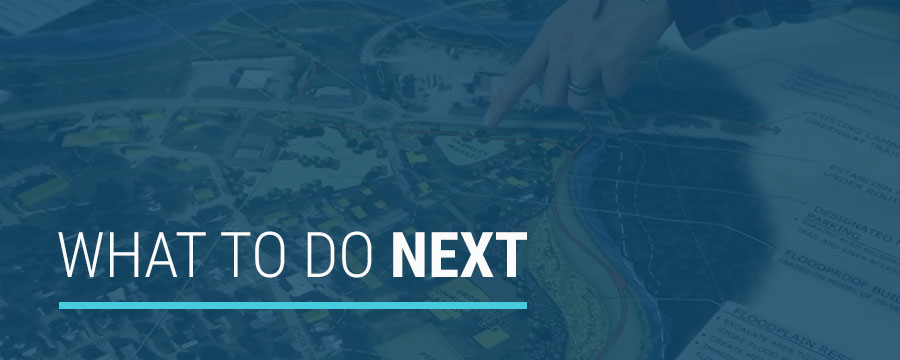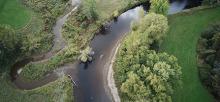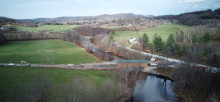There are several opportunities to make your community safer before the next flood. The questions below will help you learn more about your current situation and lead you to various strategies. When thinking about what to do first, prioritize preventing new building in risky areas by updating bylaws. Then, consider what you can do to reduce the risk your community already faces.
-
Know What's at Risk
-
What Might Flood Damage Cost Our Town?
-
Do Our Bylaws, Plans, and Standards Stop the Problem from Getting Worse?
- Are new buildings and roads in the floodplain putting existing buildings at risk?
- Are river corridors protected?
- Are our road and bridge standards current?
- Is our Local Hazard Mitigation Plan current?
- Is our Local Emergency Operations Plan current?
- Do we have a flood recovery plan to direct post-flood recovery toward safe locations as identified in the municipal plan?
- Where can we get assistance in the update process?
-
Are We Flood Ready?
- Have we taken steps to reduce risk for individuals, businesses, and the town?
- Do we have adequate first responder and road management capacity to respond to and recover from flood damage?
- Do we have adequate administrative resources to respond to and recover from flood damage?
- Do we have adequate financial resources to respond to and recover from flood damage?
-
How Can We Make Our Community Even Safer?
-
How Do We Explain How Important This Is for Our Town?

Know What's at Risk
Where are the floodplains and River Corridors?
Opportunity: Everyone can see which areas in the community are at risk of flood damage.
- Flood Ready Atlas. All River Corridors and about half of all Special Flood Hazard Areas are digitally mapped in the atlas. If data isn't in the atlas, use FEMA's printed maps or find them in your town offices.
How many buildings are at risk of a hundred year flood and how can we protect them?
Opportunity: Reduce the risk for families, businesses and the Town through building improvements.
- Get the number in the Flood Risk Report.
-
See where they are in the Flood Ready Atlas.
- Review best practices for protecting buildings.
-
Work with your Regional Planning Commission to improve your data with aerial photos, topographic information, or footprint data.
-
Get copies of Elevation Certificates for at risk buildings. Your Regional Floodplain Manager can help.
-
See how communities are adapting buildings.
Which roads, bridges, culverts and services are most at risk?
Opportunity: Keep roads passable for emergency response and recovery, schools, and businesses.
- Refer to your Local Hazard Mitigation Plan or create one and make sure there’s a geomorphic assessment.
- See what’s at risk in the Flood Ready Atlas or the FEMA maps.
- See if there’s a River Corridor Plan available that may describe the compatibility of culverts and condition of streams/rivers.
- Set priorities using municipal capital plan.
- See how communities are protecting infrastructure.
- Plan for safer infrastructure.
- Find the projects in your local culvert inventory that are most important and fundable. More information about problems with culverts and bridges may be available in your River Corridor Plan.

What Might Flood Damage Cost Our Town?
Money from FEMA after a disaster should always be thought of as the third method of defense in restoring damaged property. Often flood damage to a few sites, or even across the town, is not enough to qualify the flood as a federal disaster. Therefore, flood insurance is the second method of defense, after the first one of not building in the hazard zone at all. As long as a municipality is participating in the NFIP, flood insurance is available to all structures in the town, not just those mapped in the SFHA.
Is flood insurance available and used?
Opportunity: Ensure your community has the resources to rebuild after a disaster.
- Review your town Flood Risk Report.
- Enroll your town so residents may buy insurance.
- Encourage residents to enroll.
- Learn more about NFIP.
- Use the outreach strategies in this training series.
Will we get the maximum recovery funding assistance after a federally-declared disaster?
Opportunity: Get the federal and state governments to cover 92.5% of rebuilding costs instead of only 82.5%.
- Check your Emergency Relief and Assistance Fund status.
- Take the steps to get the full 17.5% ERAF contribution from the state.
- Find funding sources for planning and recovery.

Do Our Bylaws, Plans, and Standards Stop the Problem from Getting Worse?
Are new buildings and roads in the floodplain putting existing buildings at risk?
Opportunity: New development will have no adverse impact on existing structures in the floodplain.
- Use the Flood Risk Report and the Flood Ready Atlas to identify what is already at risk and might be put at greater risk by development.
- Adopt Flood Hazard Area model bylaw language to ensure safe development.
Are river corridors protected?
Opportunity: The stream channel will have the room it needs to find the slowest path, causing no adverse impact to structures downstream.
- Review siting of new structures.
- See how other communities are protecting River Corridors.
Are our road and bridge standards current?
Opportunity: VTrans recovery assistance is at highest level.
- Check the Flood Risk Roads Report to make sure standards meet or exceed the Orange Book. See section 6 for reference.
- Learn about opportunities to protect roads and bridges.
- Apply for grant money to get up to standard.
Is our Local Hazard Mitigation Plan current?
Opportunity: Help qualify for ERAF and plan for a safer community.
- Check your status on the Flood Risk Report.
- Adopt or update the LHMP every 5 years and apply for grants to assist with the plan.
Is our Local Emergency Operations Plan current?
Opportunity: Help qualify for ERAF and effectively meet community needs in emergencies.
- Check your status on the Flood Risk Report.
- Update the LEOP every year between town meeting day and May 1st.
Do we have a flood recovery plan to direct post-flood recovery toward safe locations as identified in the municipal plan?
Opportunity: Take advantage of the disaster to rebuild a safer community.
- Work with Regional Planning Commission to develop one so that there’s clear guidance after an event
Where can we get assistance in the update process?
Opportunity: Be supported in preparing for the best outcomes.
- Get advice and funding for plan and bylaw updates.
- Call your Regional Planning Commission and your Regional Floodplain Manager.

Are We Flood Ready?
Have we taken steps to reduce risk for individuals, businesses, and the town?
Opportunity: Reduced risk factors for next flood.
- Review opportunities on this community preparedness toolkit.
- Follow this flood resilience checklist to track progress.
- Learn lessons from past recovery efforts.
- Review how other communities are adapting buildings.
Do we have adequate first responder and road management capacity to respond to and recover from flood damage?
Opportunity: Ready to respond effectively to flood damage, no matter where in our community it strikes, even if roads wash out.
- Review your Flood Risk Report.
- Ensure Local Emergency Operations and Flood Response Plans are adequate.
- Consider where first responders and road crew members live, where they will need to get to during a flood event, and how that may influence your response.
Do we have adequate administrative resources to respond to and recover from flood damage?
Opportunity: Municipal services can still operate when most needed.
- Consider creating a continuity plan.
Do we have adequate financial resources to respond to and recover from flood damage?
Opportunity: Stable municipal budget and qualified for maximum ERAF assistance.
-
Get qualified for highest level of ERAF.
-
Does your community need to build a capital reserve to cover the remaining requirement?

How Can We Make Our Community Even Safer?
Can we slow the water down and give the river more room?
Opportunity: After ensuring we don’t make things worse, we can work to decrease the likelihood of flood damage.
-
Hire an engineer to find opportunities.
-
Remove obstructions and fill.
-
Remove structures and bank armoring from the corridor.
- See how Jeffersonville residents identified and removed problems to make their community safer.
- Read about steps other communities are taking to reduce their flood risk by moving buildings and protecting floodplains.
Is there funding available?
Opportunity: Assist with project cost to reduce risk.
-
Use the Hazard Mitigation Grant Program and other programs.
- Watch a video on home buyouts and elevation projects.

How Do We Explain How Important This Is for Our Town?
What communication tools can help us tell this story?
Opportunity: After ensuring we don’t make things worse, we can work to decrease the likelihood of flood damage.
-
Review the Getting the Word Out section of this training series for templates and tools.
-
Call your Regional Planning Commission for help with meeting facilitation, outreach, and process planning.
-
Town Meeting

Reflection Questions
- Which of the actions above would be relatively easy for your community to start with?
- What actions feel most important to take for the safety of your community?




